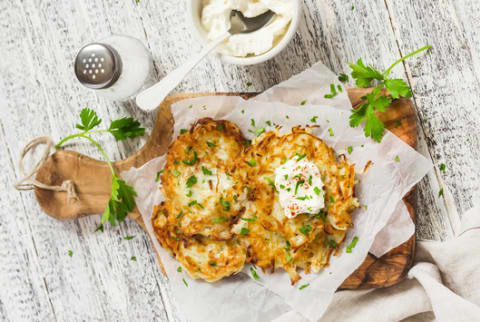Advertisement


Latkes are a staple of Hanukkah cuisine, and for good reason: There's little better than the savory-sweet combo of fried, onion-y potatoes and applesauce and sour cream. But because we're mindbodygreen, and we do things a bit differently around here, we wanted to perfect the latke recipe to make it both supremely delicious and as healthy as possible. There are a few simple steps to make the Perfect Latke (insert praise hands emoji here) for your body and your soul. Eat 'em for one night or all eight, and have the happiest of Hanukkahs!
1. Drain as much liquid as possible from your vegetables.
This is the secret to perfectly crispy latkes. You want to do it before you add your onion (because onion juice = flavor). Simply shred your potatoes (or whatever vegetable you're using—see below for more on that) and set in a large bowl. Sprinkle a bit of salt and toss throughout, as the salt will help release the vegetable's juices. After 10 minutes or so, load the potatoes into a clean dish towel, double-layered cheesecloth, or a nut milk bag (you were always looking for another use for that nut milk bag, right?). Cinch the top shut so the potatoes are in a ball, and, over a sink, squeeze, squeeze, squeeze until you've wrung out as much liquid as possible. You'll be shocked at how much comes out. All that moisture will go down the drain, where it can't sully your latkes with sogginess.
2. Use high-heat oil.
While we love olive oil, you don't want to cook with it, and you really don't want to pan-fry with it, as it has a lower smoke point and will both burn and become less-than-good for you. Our favorite healthy high-heat oils are ghee (which imparts a buttery flavor), avocado (a great neutral choice), and coconut (which adds a bit of sweetness but doesn't taste too "coconut-y").
3. Drain your latkes well.
Repeat after us: No stacking! Put your latkes in a single layer on a paper or clean dish-towel-lined plate. If the towel gets too saturated with oil, switch it out. Getting as much oil off the latkes after they cook is key for getting that final crisp-up.
4. Make 'em gluten-free!
This is optional, but if you have celiac or are avoiding gluten, you can easily use rice flour in lieu of grain flour. Just sub it in one for one—it actually results in a slightly lighter, fluffier pancakes that are supremely delicious.
5. Make 'em vegan!
This one is a bit trickier—while gluten-free latkes will definitely stand up in a taste or texture test against the classics, vegan latkes aren't quite as successful. That said, they are doable. The trick is to be very careful with them, pressing them together as you place them in the pan and flipping delicately, as they're more wont to fall apart. Simply sub each egg listed in the recipe for one flax or chia egg. If you do go with chicken eggs, it's great to choose a pastured or organic option for the health of the environment and your own body.
6. Don't stick to white potatoes.
Play around with your latkes—your basic recipe will work with any number of vegetables. We especially love zucchini and sweet potato, but go crazy: Anything with a texture firm enough to grate will typically work well in a latke. This means a parsnip latke is a delicious option, but a tomato one? Probably not.
7. Buy organic and you won't need to peel.
Much of vegetables' nutrients are in the peel, so it's a shame to throw all of that out (also, 2017 is the year we're doing something about food waste!). If you buy organic, there's really no need to peel—just scrub under running water and pat dry with a clean towel. If you don't buy organic and want to keep the skin on, simply soak your vegetable in a water bath with a splash of white or apple cider vinegar for 10 minutes before following the aforementioned scrub and dry steps. The vinegar will break down quite a bit of the pesticide residue, so you'll be good to go!
8. Season, season, season.
'Tis the season to, well, season. A well-seasoned latke is the difference between one that will wow your taste buds and one that will leave you with an overall feeling of meh. At a minimum, you'll want to salt and pepper generously (salt throughout; pepper just as the end, as it will burn and taste bitter otherwise). But play around! Some finely chopped basil adds a wonderful sweet, fresh note to latkes (especially ones with a zucchini base), and a curry mixture gives sweet potatoes a decidedly Indian flair.
Got all that? Here's a basic latke recipe to get you started!
Healthy Latkes
Ingredients
- 1 to 1½ pounds potatoes, sweet potatoes, zucchini, or vegetable of choice
- ¼ cup chopped onions
- 2 large organic or pastured eggs (or chia or flax eggs), lightly beaten
- 3 tablespoons flour or rice flour
- 1½ teaspoons salt and any additional seasonings of choice
- Black pepper to taste
- High heat oil of choice (ghee, avocado, and coconut all work well)
Method
- Using a food processor or cheese grater, grate the potatoes. Drain well using the method described above. Mix in all additional ingredients; toss to combine.
- Preheat oven to 200°F. Line a baking pan with paper towels.
- When you are ready to eat, in a large skillet heat a thin layer of high-heat oil of choice over medium-high heat until hot. Drop heaping tablespoonfuls of potato mixture and cook for 3 to 4 minutes a side; latkes should be golden and crisp on both sides. Drain on towel-lined baking sheet, then eat right away or keep warm in oven. Serve with toppings of choice.